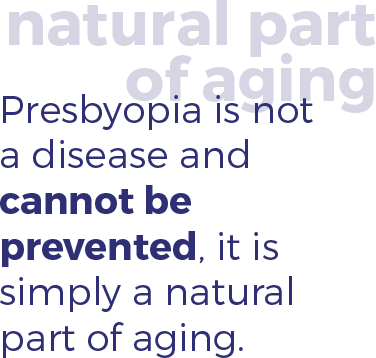Presbyopia is a refractive disorder that makes it difficult for people to see things up close. Presbyopia is a normal part of aging, typically affecting people in their early to mid-40s and older.
Presbyopia occurs when the clear lens inside the eye becomes more rigid. Typically this lens changes shape to focus light onto the retina, allowing you to focus on objects that are both close-up and far away. As people age, this lens becomes more rigid and cannot change shape as easily. This rigidity makes it difficult to see things clearly up close.
Symptoms of Presbyopia include:
・Difficulty focusing on objects up close
・Blurred vision at normal reading distance
・Eye strain
・Headache
Presbyopia gets worse over time, but typically plateaus after age 65. Presbyopia is not a disease and cannot be prevented, it is simply a natural part of aging. While there is no way to stop or reverse the normal aging process, it can be corrected with eyeglasses, contact lenses, or surgery. It may also be helpful to consider simple lifestyle changes including holding reading materials farther away, increasing digital font sizes, choosing large-print reading materials, and using brighter lights for close-up activities.

